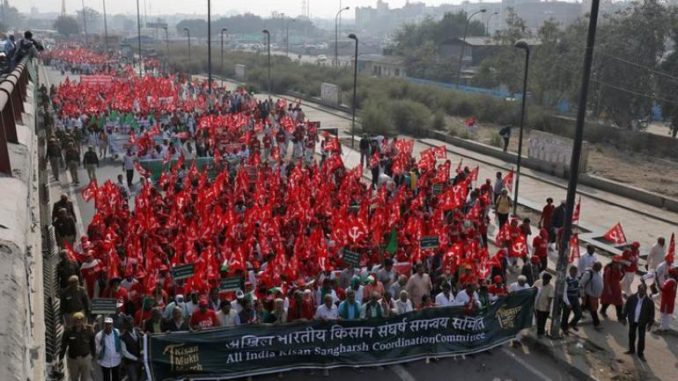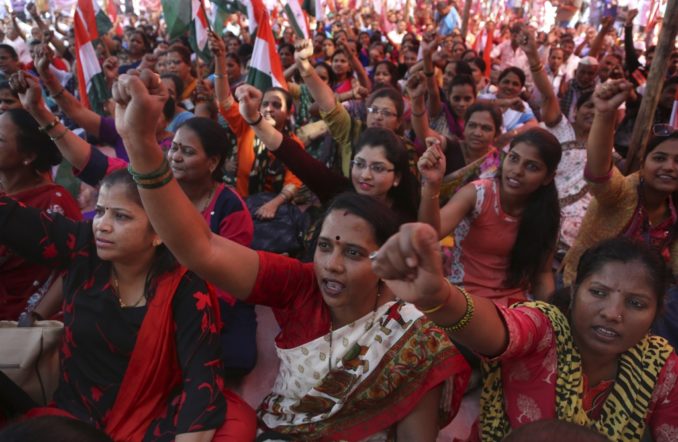All-India General Strike is largest in world history

Two hundred farmers’ unions are organized under the All India Kisan Sangharsh Coordination Committee.
It is estimated that at least 150 million workers, perhaps as many as 200 million, participated in the two-day All-India General Strike Jan. 8-9.
The strike was probably the largest general strike in world labor history.
Although generally ignored by the Western capitalist news media, this was a world-shaking event. Workers throughout India participated — from the largest cities of Mumbai (12 million plus) and Delhi (11 million plus) to the 67 percent of the country that remains rural.
Workers in government, banking, transit, manufacturing, transportation, education, agriculture and the informal economy were among those walking out. Every sector of the economy experienced slowdowns and in some cases total shutdowns.
As of 2017, India’s population was 1.34 billion people; only China’s population is larger. One in six people in the world live in India. Of those 1.34 billion, at a bare minimum more than 1 in 9 took part in the strike.
Or about one striker for every 50 people in the entire world!
Classwide unity
As in other general strikes against the current government, 10 of India’s different labor federations, along with various independent unions, came together and struck as one. The politics of these federations range from conservative to revolutionary. According to British blogger Jamie Woodcock, who witnessed the strike’s impact in Bangalore, “The majority of the workers were aligned with the ‘red’ unions, and political parties were playing an important role.” (notesfrombelow.org)
Prominent in strike photos are the red banners of the All-India Trade Union Congress, which is India’s second largest labor federation and the largest with left-wing leadership. Founded in 1920, AITUC is also the oldest labor federation in India and is affiliated with the World Federation of Trade Unions, which AITUC co-founded in 1945.
“The crowd of workers was diverse, with a large number of women, as well as significant numbers of visible Muslims,” Woodcock noted. Muslims are the largest of many religious minorities in India, whose population is 80 percent Hindu. India has over 2,000 ethnic groups, speaking many languages that belong to four distinct linguistic families.
Women have played a major role in the ongoing struggle against the neoliberal government of Narendra Modi. In a 2016 interview with this writer, AITUC General Secretary Amarjeet Kaur spoke about women’s participation in the Sept. 2, 2016, general strike: “Women were essential because they are hard hit. All the social security investment which the government is reducing is hitting women because it is making education, health, drinking water and food items expensive. Good jobs and opportunities are being lost. Women are being engaged only in precarious jobs, where wages are not protected at all, so women’s participation in our strike was immense. They were in the forefront everywhere.” (“Women & the All-India Trade Union Congress,” Workers World, Nov. 20, 2016)

Workers massed in Mumbai during Jan. 8-9 strike.
‘A clear warning from the working class’
Unions built the mass work stoppage around 12 demands. The first opposes Prime Minister Modi’s efforts to dismantle the 1926 Labor Law, demanding the government “stop all pro-corporate, anti-worker amendments.” Other demands address inflation, privatization, the right to unionize, irregular and “non-permanent” employment, social security for unorganized workers, the Foreign Direct Investment policy in banking, high unemployment and pensions.
The strike’s strength extended far beyond the unionized sector, which is only about 30 million workers, a majority of them in government.
Student and farmer organizations supported the strike. Farmers engaged in road and rail blockades to back the strike demands and “to save rural farmers’ lands from the corporate.” (Times Now News, Jan. 8)
Strike leaders were arrested, including Communist Party of India (Marxist) leaders from West Bengal, Sujan Chakraborty and Anadi Sahoo, who were detained in Kolkata, along with their comrades from Jadavpur.
“The struggle will continue,” Chakraborty stated emphatically. Tapan Sen, general secretary of the Centre of Indian Trade Unions, added, “This strike is a clear warning from the working class and toiling people of India that they were not going to take lying down the attacks on their basic rights and living conditions.” (The Morning Star, Jan. 8)

